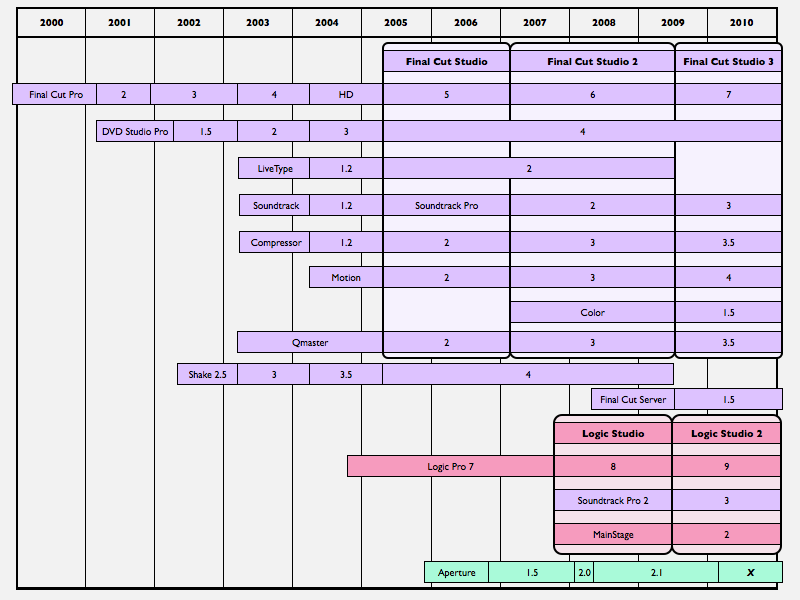Apple preparing Aperture X upgrade to 3.0 [u]
The book is listed as "Apple Aperture X (3) - UNDER NDA: A Workflow Guide for Digital Photographers," and the 320-page paperback from Focal Press has a release date of May 26, 2010, perhaps suggesting a timeframe for the forthcoming software's release.
The forthcoming book's ISBN number is 978-0240521787. According to isbn.nu, it is not available for preorder anywhere other than Amazon, where the title implies it remains under a non-disclosure agreement, suggesting its posting was a mistake.
The product description states that the guide is "fully updated for Aperture X." It offers no details on the future software.
"Aperture is a dedicated end-to-end workflow tool for photographers, and this book guides the reader through the complete process from capture to input," the listing reads. "The beauty of Aperture is that — unlike Adobe's rival workflow software, Lightroom — it doesn't force a particular structure or workflow on the user. This more open-ended approach means it is becoming increasingly popular with photographers — but also means that there is a lot to learn fro a newcomer to the software."
The authors are listed as Ken McMahon and Nik Rawlinson, who also co-wrote "Apple Aperture 2: A workflow guide for digital photographers," released in 2008. McMahon has also authored books on Paint Shop Pro and InDesign, while Rawlinson has written the 2009 edition of "The Ultimate iPod Guide."
Aperture hasn't seen a major reference release since 2.0 shipped in February 2008, when Apple reduced the original $499 price tag to $199 in order to spur sales after two years of mixed reviews.
Since 2.0, the company has issued a half-dozen minor updates at regular intervals, each primarily addressing performance and stability issues. However, just weeks after the release of 2.0, Apple delivered Aperture 2.1 with a significant new feature: support for new plugins intended to create a third party ecosystem around the product. Since then over six dozen Aperture 2 plugins have been developed by a variety of publishers.
Aperture vs Lightroom
Just months after Aperture was first released, it was met with potential competition from an experimental new app called Lightroom, which emerged from Adobe Labs as a Mac-only beta in January 2006. It officially shipped as a 1.0 release a little over a year later for both Mac OS X and Windows under the name "Photoshop Lightroom."
Last year, Adobe released Photoshop Lightroom 2.0; earlier this year, Adobe cited statistics stating that 44.4% of professional photographers using Macs were using Lightroom compared to 12.5% using Aperture. Across all photographers in the survey of 1,045 users on both Macs and Windows, 37% used Lightroom, 6.4% used Aperture, and 57.9% reported simply using the Photoshop Camera Raw plugin.
Adobe's successful entry into the photography workflow market caused Apple grief not just because of Lightroom's popularity, but also because the company now has to balance competing against Adobe with championing Lightroom for being one of the first major, modern Mac OS X Cocoa apps built from scratch as well one of the first and few 64-bit apps released for the Mac.
64-bit Pro Apps
Adobe has expressed an intention to deliver other 64-bit Mac apps, but was stymied by Apple's decision to drop 64-bit support for portions of the legacy Carbon API required to develop graphical applications. This decision was announced at Apple's WWDC event in June 2007, sending Adobe and other long time Mac developers back to the drawing board.
In the nearly two and half years since it announced its Cocoa-only strategy for 64-bit apps on Mac OS X, Apple has converted nearly all of the apps bundled in Mac OS X Snow Leopard to run as 64-bit programs, with the notable exception of iTunes, iLife apps, iWork apps, and the company's Pro Apps.
Many users were surprised to see Apple release new 32-bit versions of its Pro Apps in this summer's announcement of Final Cut Pro 7 and its companion apps in Final Cut Studio 3.0 (Motion, Soundtrack Pro, Color, and Compressor) as well as Logic Pro 9 and its suite of apps.
X marks the spot
The apparent renaming of Aperture X and its release slated sometime early next year suggests that Apple may be planning a rebranding of its entire Pro App library with the "X" version for 2010, and could take the opportunity to deliver 64-bit upgrades at that time as well. The company began naming versions of its iLife and iWork packages after the year of their release starting in 2004, so iLife X and iWork X would also also fit into this same naming convention for the new year.
In addition to its use in Mac OS X, Apple also applied the Roman numeral X version to QuickTime with the release of Snow Leopard this year, even though the previous version was 7.6; the new 64-bit version is now specified as 10.0, and Apple's marketing refers to it as QuickTime X.
In addition to using "X for ten," Apple also uses (and pronounces) X as the letter in relation to several server and development products, including its Xserve hardware, Xsan clustering filesystem, Xcode development tools, and Xgrid distributed computing technology.
Mac OS X, Xcode, and Xgrid are all based upon technologies derived from Steve Jobs' NeXT, Inc., which Apple acquired in 1997. Apple's subsequent frequent use of "X" was closely associated with NeXT and Jobs, who also popularized the "i" in iMac, iPod, iApps, iSight, iPhone, and initially to himself as Apple's "iCEO."
 Prince McLean and Neil Hughes
Prince McLean and Neil Hughes












 Andrew Orr
Andrew Orr
 Marko Zivkovic
Marko Zivkovic
 David Schloss
David Schloss

 Malcolm Owen
Malcolm Owen

 William Gallagher
William Gallagher
 Mike Wuerthele
Mike Wuerthele






